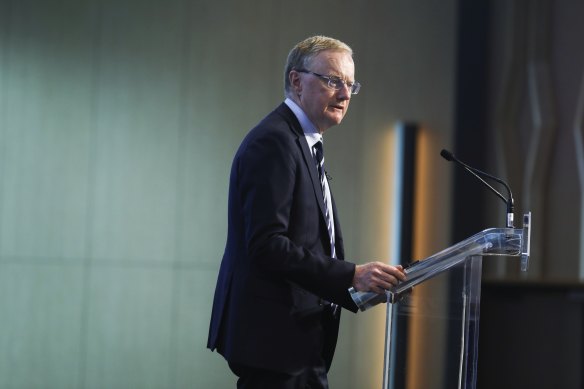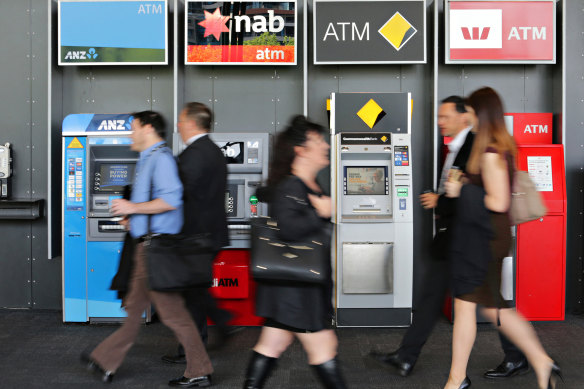Why the RBA inquiry should propose something much better

The inquiry into the Reserve Bank, due to report this month, will be disappointing if it does no more than suggest modest improvements in the way it does its job. The question it should answer is: should we give so much responsibility to an institution with such a limited instrument – interest rates – and with such a narrow focus?
In Reserve Bank governor Dr Philip Lowe’s lengthy appearance before the House of Representatives Economics Committee last month, he spent much of his time reminding critics that he only has one tool, so he can’t do anything to resolve the problems they were complaining about.
Governor of the Reserve Bank Phillip Lowe.Credit:Renee Nowytager
He’s right. But if the problems are real, and he can’t do anything about them, why should the central bank be the top dog when it comes to managing the economy, and Treasury’s job be limited to worrying about debt and deficit?
Shouldn’t the greatest responsibility go to an institution with more instruments, and ones capable of doing more tricks?
By the way, if you’re wondering why I’ve had so much to say recently about the limitations of monetary policy and the questionable convention of making it dominant in the management of the macroeconomy, it’s because it’s the obvious thing to do while we’re holding an inquiry into Reserve Bank’s performance.
Frenchman Olivier Blanchard, one of the world’s top macroeconomics, recently caused a storm when he tweeted about “a point which is often lost in discussions of inflation and central bank policy”.
“Inflation,” he wrote, “is fundamentally the outcome of the distributional conflict between firms, workers and taxpayers. It stops only when the various players are forced to accept the outcome.”
Oh, people cried, that can’t be right. Inflation is caused when the demand for goods and services exceeds the supply of them.
In truth, both propositions are correct. At the top level, inflation is simply about the imbalance between demand and supply. At a deeper level, however, “distributional conflict” between capital and labour can be the cause of that imbalance.
Businesses add to inflation when they seek to increase their profit margins. Workers and their unions add to inflation when they seek to increase their real wages by more than the productivity of labour justifies.
Central banks’ interest-rate instrument can fix the problem only indirectly and brutally: by weakening demand until the warring parties are forced to suspend hostilities.
But this way of thinking is disconcerting to central bankers because – though there may well be a way of reducing inflation pressure by reducing the conflict between labour and capital – there’s nothing the Reserve can do about it directly.
Central banks’ interest-rate instrument can fix the problem only indirectly and brutally: by weakening demand (spending) until the warring parties are forced to suspend hostilities. So distributional conflict is the first thing monetary policy (the manipulation of interest rates) can’t really fix.
Then there’s inflation caused by other supply constraints, such as the pandemic or wars. Again, monetary policy can’t fix the constraint, just bash down demand to fit.
The next things monetary policy doesn’t do are fairness and effectiveness. Then we’re trying to reduce inflation by reducing people’s ability to consume goods and services, it would be nice to do so with a tool that shared the burden widely and reasonably evenly.
A temporary increase in income tax or GST would do that, but increasing interest rates concentrates the burden on people with big mortgages. This concentration means the increase has to be that much greater to achieve the desired slowing in total consumer spending.
A further dimension of monetary policy’s unfairness is the way it mucks around with the income of savers. Their interest income suddenly dives when the Reserve decides it needs to encourage people to borrow and spend.
In theory, this is made up for when the Reserve decides to discourage people from borrowing and spending, as now. In practice, however, the banks drag their feet in passing higher interest rates on to their depositors. But it’s rare for the Reserve even to chivvy the banks for their tardiness.
Governments need to be free to encourage or discourage consumers from spending. But where’s the justification for doing this by riding on the backs of young people saving for a home and old people depending on interest income to live on?
When interest rates rise, the big four banks tend to drag their feet on passing them on to savers.Credit:Paul Rovere
The next thing monetary policy doesn’t do is competition. What’s supposed to keep prices no higher than they absolutely need to be is the strength of competition between businesses. You’d think this would be a matter of great interest to the Reserve, especially since there are signs that businesses increasing their “markups” are part of the present high inflation.
But only rarely does the Reserve mention the possibility, and only in passing. It gives no support to the Australian Competition and Consumer Commission’s efforts to limit big firms’ pricing power.
The final thing monetary policy doesn’t do is housing. The Reserve is right to insist that its increases in interest rates aren’t the main reason homes have become so hard to afford.
The real reason is the failure of governments to increase the supply of homes in the places people want to live – close to the centre of the city, where the jobs are – exacerbated by their failure to provide decent public transport to outer suburbs.
But the ups and downs of mortgage interest rates must surely be making affordability worse. To this, Lowe’s reply is that, sorry, he’s got a job to do and only one instrument to do it with, so he can’t be worried about the collateral damage he’s doing to would-be young home buyers.
Well, he can’t be worried, but his political masters can. And if they’re not game to fix the fundamental factors driving up house prices, they should be willing to create an instrument for the short-term management of demand that doesn’t cause as many adverse side effects as using interest rates does.
The one big thing going for monetary policy as a way of keeping the economy on track is that the Reserve’s independence of the elected government allows it to put the economy’s needs ahead of the government’s need to sync the economy with the next election.
But, as various respected economists have pointed out, there’s no reason the government can’t design a fiscal instrument, giving another body the ability to raise or lower it within a specified range, and making that body independent, too.
It’s the Reserve Bank inquiry’s job to give the government some advice on why and how it should make a change for the better.
Ross Gittins is the economics editor.
Ross Gittins unpacks the economy in an exclusive subscriber-only newsletter every Tuesday evening. Sign up to receive it here.
Most Viewed in Business
From our partners
Source: Read Full Article


